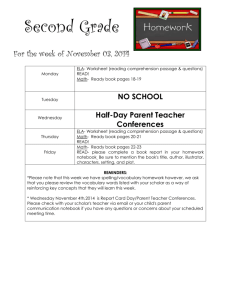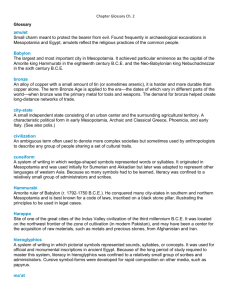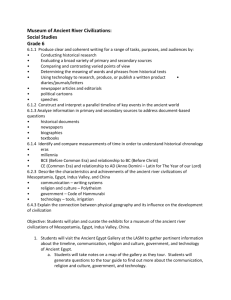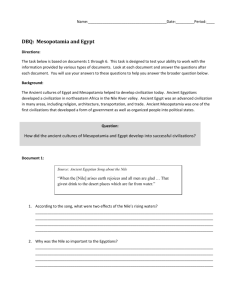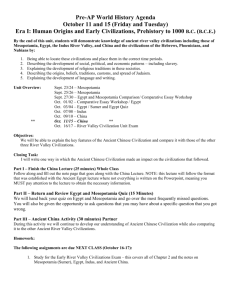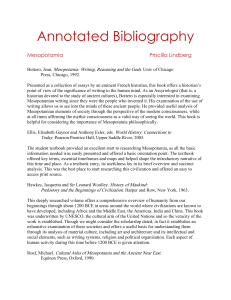Unit Plan
advertisement
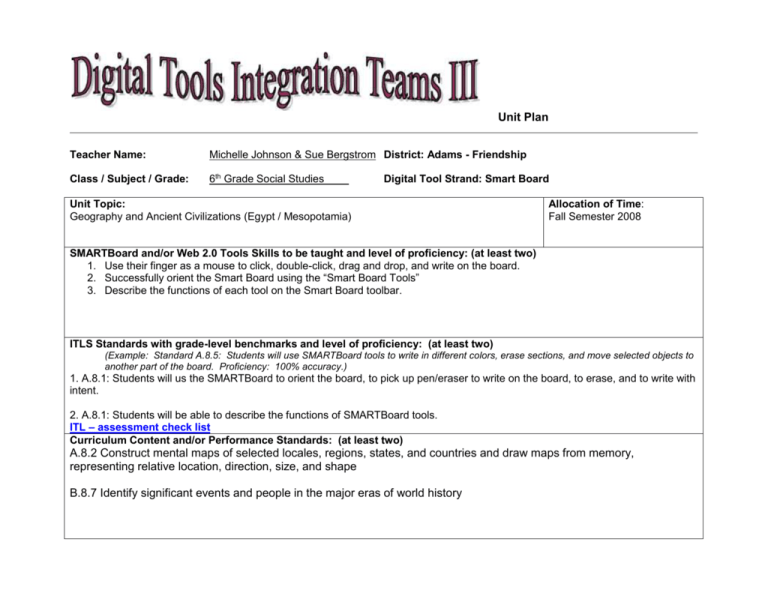
Unit Plan Teacher Name: Michelle Johnson & Sue Bergstrom District: Adams - Friendship Class / Subject / Grade: 6th Grade Social Studies Digital Tool Strand: Smart Board Unit Topic: Geography and Ancient Civilizations (Egypt / Mesopotamia) Allocation of Time: Fall Semester 2008 SMARTBoard and/or Web 2.0 Tools Skills to be taught and level of proficiency: (at least two) 1. Use their finger as a mouse to click, double-click, drag and drop, and write on the board. 2. Successfully orient the Smart Board using the “Smart Board Tools” 3. Describe the functions of each tool on the Smart Board toolbar. ITLS Standards with grade-level benchmarks and level of proficiency: (at least two) (Example: Standard A.8.5: Students will use SMARTBoard tools to write in different colors, erase sections, and move selected objects to another part of the board. Proficiency: 100% accuracy.) 1. A.8.1: Students will us the SMARTBoard to orient the board, to pick up pen/eraser to write on the board, to erase, and to write with intent. 2. A.8.1: Students will be able to describe the functions of SMARTBoard tools. ITL – assessment check list Curriculum Content and/or Performance Standards: (at least two) A.8.2 Construct mental maps of selected locales, regions, states, and countries and draw maps from memory, representing relative location, direction, size, and shape B.8.7 Identify significant events and people in the major eras of world history Learning Objectives: What students will learn… Students will be able to correctly identify the locations of the 7 continents 5 oceans, 4 hemispheres and the 4 major lines of demarcation. Students will be able to identify the location of ancient civilizations. (Egypt, Mesopotamia-Iraq, India, China) Students will be able to state and categorize the contributions made by ancient civilizations to today’s society. Students will be able to identify / compare and contrast, the time period in which each civilization occurred. Specific Learning Goals for the Units addressed (required by district) Geography: September The first unit of Study will be general geography skills. Students will be able to identify / label all continents, oceans, and lines of demarcation. Students will also have the ability to find a location using lines of latitude and lines of longitude. Students know how to use lines of latitude and longitude to find a location. Students know the major land formations and water areas of the world. Students know that timelines show the history of events in chronological order. The following documents were used to help meet these goals. (See hard copies, notebook files and digital tools document for webbased resources.) Mesopotamia: October The second unit of study revolves around the ancient civilization of Mesopotamia, which is modern day Iraq. The learning goals that will be addressed are as follows. Students will know that Mesopotamia is today’s Iraq? Students will understand how the geographical features of Iraq/ Mesopotamia helped the people of the civilization. Students will be able to locate continents, oceans, lines of latitude, longitude as well as the location of Mesopotamia. Students will be able to understand how natural resources can affect a civilization. Students will know what the ancient civilization of Mesopotamia invented and how their inventions contributed to future civilizations and to our society. Students will learn what contributions the ancient world of Mesopotamia gave us. o Specifically, students will be able to explain how the development of writing is a major contribution. Students will know and understand basic historical facts about the Mesopotamian Life: Government, Gods, Geography, Culture, Inventions. Students know that Hammarabbi developed the Code of Law and he is one of the first individuals to write laws that citizens follow. His laws were even used – his symbol is on the Congress buildings…. Students will demonstrate their understanding of vocabulary and concepts taught. Students will understand that the Tower of Babel and The Hanging Gardens of Babylon are listed as one of the worlds great wonders, but they may never have existed. The following documents were used to help meet these goals. ( See hard copies, notebook files and digital tools document for web based resources. ) Egypt: November The third unit of study revolves around the ancient civilization of Egypt. The following learning goals will be addressed. Students will be able to locate Egypt and all of the other geographical locations taught on a map. Students will know that the Nile is the longest River in the world. Students will be able to explain the “gifts” of the Nile Students will be able to distinguish between the major time periods of Egypt. Old, Middle and New. Students can create a time line of those time periods with the help of a resource. Students understand the class system of ancient Egypt and how it is similar to today’s society. Students understand the viewpoint of ancient Egypt’s afterlife and can explain the reason for mummification. Students can identify and describe key achievements / contributions of ancient Egypt. (pyramids, mummification, paper, irrigation, domestication of animals…etc. Students understand the basics of the pyramid construction and the importance they held for the Egyptian afterlife. Students understand that the Egyptians, like the Mesopotamians, believed in polytheism. Many Gods. Students will be able to accurately represent events on a timeline as they relate to ancient Mesopotamia and ancient Egypt. Learning Goals: are posted on the SmartBoard daily. The following documents were used to help meet these goals. ( See hard copies, notebook files and digital tools document for web based resources. ) Step-by-step Unit Plan and Timeline September – Geography Unit enhanced by SMARTBorad interactive activities. (ie.. ) October-November-Ancient Civilizations 1-Mesopotamia / Iraq 2- Egypt Some SMARTBoard tools that will be used to enhance learning goals will not be limited to, but will include, CATEGORY SORT, FLIPPERS, TIMELINES, (Categorize contributions of various civilizations using IMAGE MATCH) JEOPARDY STYLE QUIZ GAMES. Jeopardy – Egyptian Style 7 Wonders of The Ancient World Continents Egypt Geography Egypt Quiz Mesopotamia Quiz Resources that will be used to develop understanding… ** List resources and attach copies of any handouts created for the unit. Resources & Technology Tools**: Activities for the SMARTBoard Geography Resources (web based) – www.iknowthat.com (interactive continent / ocean game) Mesopotamia Resources (web based) http://www.mesopotamia.co.uk/geography/index.html (geography of Mesopotamia) http://www.mesopotamia.co.uk/gods/index.html (gods and goddesses of Mesopotamia) http://www.mesopotamia.co.uk/time/index.html (history of Mesopotamia) http://www.mesopotamia.co.uk/writing/home_set.html (Mesopotamia cuneiform) Egypt Resources (web based) http://school.discoveryeducation.com/lessonplans/programs/makingmummies/ (mummies around the world) http://school.discoveryeducation.com/lessonplans/programs/mummytales/ (info about mummies) http://www.worldtrek.org/odyssey/teachers/egyptlessons.html (achievements and challenges of Egypt) http://www.iwebquest.com/egypt/ancientegypt.htm (web quest about Ancient Egypt) http://kids.discovery.com/fansites/tutenstein/mummymaker/mummymaker.html (make a mummy!) http://www.nationalgeographic.com/tv/mummy/ (how to make a mummy) http://www.salariya.com/web_books/mummy/ (cartoon version of making a mummy-very funny) http://www.schoolhistory.co.uk/games/walk/walk_egypt.html (interactive quiz format -Egypt, Rome and Greece) http://www.bbc.co.uk/history/ancient/egyptians/launch_gms_mummy_maker.shtml (interactive creation of a mummy) http://www.bbc.co.uk/history/ancient/egyptians/launch_gms_pyramid_builder.shtml (interactive construction of a pyramid) http://www.ancientegypt.co.uk/life/index.html (Egyptian life) http://www.ancientegypt.co.uk/geography/index.html (Egyptian geography) http://www.ancientegypt.co.uk/gods/index.html (gods and goddesses) http://www.ancientegypt.co.uk/mummies/index.html (Egyptian mummies) http://www.ancientegypt.co.uk/pharaoh/index.html (Egyptian pharaohs) http://www.ancientegypt.co.uk/pyramids/index.html (Egyptian pyramids) http://www.ancientegypt.co.uk/temples/index.htmlEgyptian temples) http://www.ancientegypt.co.uk/time/index.html ( Egyptian history-continuity) http://www.ancientegypt.co.uk/trade/home.html (Egyptian craftsmen) http://www.ancientegypt.co.uk/writing/index.html (Egyptian hieroglyphics) Videos – (web based) http://www.teachertube.com/view_video.php?viewkey=76a6704b08093c652fd7 - Hey, Hey, Hatshepsut! http://www.teachertube.com/view_video.php?viewkey=5f4d01dd9b1a97129016 -Mesopotamia http://www.teachertube.com/view_video.php?viewkey=c23a038f787ddbb6f243 Mesopotamia / Sumerians http://www.teachertube.com/view_video.php?viewkey=de73bbc8ab3da0084a3a&page=&viewtype=&category= Egypt / Mesopotamia Slide Show http://www.teachertube.com/view_video.php?viewkey=ff10d18b9db53d7911cc - Cradle of Civilization http://www.teachertube.com/view_video.php?viewkey=4eb0d69886a583b33de4&page=1&viewtype=&category= Timeline of Ancient Civilizations Videos – VHS / DVD Ancient Civilizations for Children – Ancient Egypt Schlessinger Media Ancient Civilizations for Children – Ancient Mesopotamia Schlessinger Media Pyramid – By David McCullahy Management Issues and Potential Solutions: 1. Too many student volunteers. Random selection of student facilitators / volunteers. 2. Technology difficulties – have backup lesson plans that do not require technology. 3. Back order of SMARTBoards – Arrange a swap / schedule with teachers that have existing boards. Differentiation Strategies: Strategies to make sure that all students can be successful… Make sure to use pictures as often as possible for students with reading difficulties. Allow students the chance to work within groups or partners. Provide hard copies of notes / activities from the SMARTBoard lessons (if appropriate) Work closely and accept feedback from EEN staff. (Team taught lessons) Provide ongoing assessments that will indicate student learning. Please attach handouts, resources, and assessment instruments to use with this unit. Submit electronically to: Jennifer Casper casperj@cesa5.k12.wi.us by December 12, 2008 and May 1, 2009
